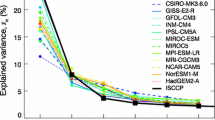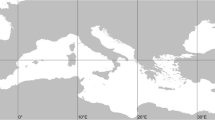Abstract
The temporal and spatial variability of winter total cloud cover in southern Europe and the Mediterranean region and its connection to the synoptic-scale features of the general atmospheric circulation are examined for the period 1950–2005, by using the diagnostic and intrinsic NCEP/NCAR Reanalysis data sets. At first, S-mode factor analysis is applied to the time series of winter cloud cover, revealing five factors that correspond to the main modes of inter-annual variability of cloudiness. The linkage between each of the five factors and the atmospheric circulation is examined by constructing the 500 hPa and 1,000 hPa geopotential height anomaly patterns that correspond to the highest/lowest factor scores. Then, k-means cluster analysis is applied to the factor scores time series, classifying the 56 years into six distinct clusters that describe the main modes of spatial distribution of cloudiness. Eventually, canonical correlation analysis is applied to the factor scores time series of: (1) 500 and 1,000 hPa geopotential heights over Europe and the North Atlantic Ocean and (2) total cloud cover over southern Europe and the Mediterranean, in order to define the main centers of action in the middle and the lower troposphere that control winter cloudiness variability in the various sub-regions of the area under study. Three statistically significant canonical pairs are revealed, defining the main modes of atmospheric circulation forcing on cloudiness variability. North Atlantic oscillation and European blocking activity modulate the highest percentage of cloudiness variability. A statistically significant negative trend of winter cloudiness is found for central and southern Europe and the Mediterranean region. This negative trend is associated with the corresponding positive trends in NAO and European blocking activity.















Similar content being viewed by others
References
Abakumova GM, Feigelson EM, Russak V, Stadnik VV (1996) Evaluation of long-term changes in radiation, cloudiness and surface temperature on the territory of the former Soviet Union. J Clim 9:1319–1327
Alpert P, Neeman BU, Shay-El Y (1990) Intermonthly variability of cyclone tracks in the Mediterranean. J Clim 3:1474–1478
Anderson TW (1984) An introduction to multivariate statistical analysis. Wiley, New York
Barnett T, Preisendorfer R (1987) Origins and levels of monthly and seasonal forecasts skill for the United States surface air temperatures determined by canonical correlation analysis. Mon Weather Rev 115:1825–1850
Barriopedro D, García-Herrera R, Lupo AR, Hernández E (2006) A climatology of northern hemisphere blocking. J Clim 19:1042–1063
Bartzokas A, Metaxas DA (1993) Covariability and climatic changes of the lower-troposphere temperatures over the northern hemisphere. Il Nuovo Cimento 16C(4):359–373
Bartzokas A, Lolis CJ, Metaxas DA (2003) The 850 hPa relative vorticity centres of action for winter precipitation in the Greek area. Int J Climatol 23:813–828
Bretherton CS, Smith S, Wallace J (1992) An intercomparison of methods for finding coupled patterns in climate data. J Clim 5:541–560
Corte-Real J, Zhang X, Wang X (1995) Large-scale circulation regimes and surface climatic anomalies over the Mediterranean. Int J Climatol 15:1135–1150
Davis RE, Walker DR (1992) An upper air synoptic climatology of the western United States. J Clim 5:1449–1467
Diaz AF, Studzinski CD, Mechoso CR (1998) Relationships between precipitation anomalies in Uruguay and southern Brazil and sea surface temperature in the Pacific and Atlantic oceans. J Clim 11:251–271
Dünkeloh A, Jacobeit J (2003) Circulation dynamics of Mediterranean precipitation variability 1948–98. Int J Climatol 23:1843–1866
Hatzianastassiou N, Fotiadi A, Matsoukas C, Pavlakis KG, Drakakis E, Hatzidimitriou D, Vardavas I (2004a) Long-term global distribution of Earth’s shortwave radiation budget at the top of atmosphere. Atmos Chem Phys 4:1217–1235
Hatzianastassiou N, Matsoukas C, Hatzidimitriou D, Pavlakis C, Drakakis M, Vardavas I (2004b) Ten year radiation budget of the earth: 1984–93. Int J Climatol 24:1785–1802
Hurrel JW, van Loon H (1997) Decadal variations in climate associated with the North Atlantic oscillation. Clim Change 36:301–326
Jolliffe IT (1986) Principal component analysis. Springer, New York
Kalkstein LS, Nichols MC, Barthel CD, Greene JS (1996) A new spatial synoptic classification: application to air mass analysis. Int J Climatol 16:983–1004
Kalnay E, Kanamitsu M, Kistler R, Collins W, Deaven D, Gandin L, Iredell M, Saha S, White G, Woollen J, Zhu Y, Leetmaa A, Reynolds B, Chelliah M, Ebisuzaki W, Higgins W, Janowiak J, Mo KC, Ropelewski C, Wang J, Jenne R, Joseph D (1996) The NCEP/NCAR 40-Year Reanalysis Project. Bull Am Meteorol Soc 77:437–471
Keevallik S, Russak V (2001) Changes in the amount of low clouds in Estonia (1955–1995). Int J Climatol 21:389–397
Kistler R, Kalnay E, Collins W, Saha S, White G, Woollen J, Chelliah M, Ebisuzaki W, Kanamitsu M, Kousky V, van den Dool H, Jenne R, Fiorino M (2001) The NCEP/NCAR 50-year reanalysis: monthly means CD-ROM and documentation. Bull Am Meteorol Soc 82:247–267
Kutiel H, Maheras P (1998) Variations in the temperature regime across the Mediterranean during the last century and their relationship with circulation indices. Theor Appl Climatol 61:39–53
Lolis CJ, Bartzokas A, Katsoulis BD (2002) Spatial and temporal 850 hPa air temperature and sea-surface temperature covariances in the Mediterranean region and their connection to atmospheric circulation. Int J Climatol 22:663–676
Lolis CJ, Bartzokas A, Katsoulis BD (2004) Relation between sensible and latent heat fluxes in the Mediterranean and precipitation in the Greek area during winter. Int J Climatol 24:1803–1816
Maheras P, Flocas HA, Patrikas I, Anagnostopoulou C (2001) A 40 year objective climatology of surface cyclones in the Mediterranean region: spatial and temporal distribution. Int J Climatol 21:109–130
Maheras P, Tolika K, Anagnostopoulou C, Vafiadis M, Patrikas I, Flocas H (2004) On the relationships between circulation types and changes in rainfall variability in Greece. Int J Climatol 24(13):1695–1712
Manly BFJ (1986) Multivariate statistical methods: a primer. Chapman and Hall, London, 159 pp
Metaxas DA (1978) Evidence on the importance of diabatic heating as a divergence factor in the Mediterranean. Arch Met Geoph Biokl Ser A 27:69–80
Metaxas DA, Bartzokas A (1994) Pressure covariability over the Atlantic, Europe and N. Africa. Application: centers of action for temperature, winter precipitation and summer winds in Athens, Greece. Theor Appl Climatol 49:9–18
Norris JD (2000) Interannual and interdecadal variability in the storm track, cloudiness and sea surface temperature over the summertime North Pacific. J Clim 13(2):422–430
Overland JE, Preisendorfer RW (1982) A significant test for principal components applied to cyclone climatology. Mon Weather Rev 110:1–4
Prezerakos NG, Michaelides SC, Vlassi AS (1990) Atmospheric conditions associated with the initiation of north-west African depressions. Int J Climatol 10:711–729
Quadrelli R, Pavan V, Molteni F (2001) Wintertime variability of Mediterranean precipitation and its links with large-scale circulation anomalies. Clim Dyn 17:457–466
Richman MB (1986) Rotation of principal components. J Climatol 6:293–335
Rossow WB, Lacis AA (1990) Global seasonal cloud variations from satellite radiance measurements. Part II: cloud properties and radiative effects. J Clim 3:1204–1253
Sahsamanoglou HS, Makrogiannis TJ, Kallimopoulos PP (1991) Some aspects of the basic characteristics of the Siberian anticyclone. Int J Climatol 11:827–839
Sharma S (1995) Applied multivariate techniques. Wiley, New York
Sugar CA, James GM (2003) Finding the number of clusters in a dataset: an information-theoretic approach. J Am Stat Assoc 98(463):750–763
Sun B, Groisman PY (2000) Cloudiness variations over the former Soviet Union. Int J Climatol 20:1097–1111
Thorncroft CD, Flocas HA (1997) A case study of Saharan cyclogenesis. Mon Weather Rev 125:1147–1165
Trigo IF, Bigg GR, Davies TD (2002) Climatology of cyclogenesis mechanisms in the Mediterranean. Mon Weather Rev 130:549–569
Trigo RM, Trigo IF, DaCamara CC Osborn TJ (2004) Climate impact of the European winter blocking episodes from the NCEP/NCAR Reanalyses. Clim Dyn 23:17–28
Wanner H, Bronnimann S, Casty C, Gyalistras D, Luterbacher J, Schmutz C, Stephenson DB, Xoplaki E (2001) North Atlantic oscillation: concepts and studies. Surv Geophys 22(4):321–382
Wibig J (1999) Precipitation in Europe in relation to circulation patterns at the 500 hPa level. Int J Climatol 19:253–269
Xoplaki E, Luterbacher J, Burkard B, Patrikas I, Maheras P (2000) Connection between the large-scale 500 hPa geopotential height fields and precipitation over Greece during wintertime. Clim Res 14:129–146
Ziv B, Saaroni H, Alpert P (2004) The factors governing the summer regime of the eastern Mediterranean. Int J Climatol 24:1859–1871
Author information
Authors and Affiliations
Corresponding author
Rights and permissions
About this article
Cite this article
Lolis, C.J. Winter cloudiness variability in the Mediterranean region and its connection to atmospheric circulation features. Theor Appl Climatol 96, 357–373 (2009). https://doi.org/10.1007/s00704-008-0046-0
Received:
Accepted:
Published:
Issue Date:
DOI: https://doi.org/10.1007/s00704-008-0046-0




